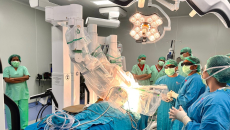Precision Medicine
In the year ahead, a new president and new policies won't be the only changes in store as artificial intelligence, cybersecurity, virtual care, digital therapeutics, reimbursement and more continue to evolve.
The Coalition for Health AI is offering its Applied Model Card artificial intelligence transparency tool on GitHub to build "the kind of trust that we need," says its CEO Dr. Brian Anderson.
For seven years, the cardiac surgical team has leveraged computational fluid dynamics software to provide consistent preoperative planning for pediatric congenital heart disease patients and improve outcomes. Sharing workflows is reaching more patients.
Also, AIIMS Delhi is setting up a hub for healthcare AI development with GE HealthCare.
The project aims to uncover markers of cardiovascular diseases specific to the Asian population.
An AI chatbot is helping clinicians explain how artificial intelligence models, fueled by evidence-based healthcare data, can speed research advancements and improve patient access.
Also, the South Korean government will pilot an electronic system to maintain the patient medical records at shuttered health facilities.
A pilot validation study found that the AI helped hasten case reviews and data analysis and determine the necessity of antibiotic use.
The interdisciplinary center will combine artificial intelligence with data science and genomics at Mount Sinai Hospital in New York City.
By partnering with Meharry Medical College, the cloud giant says it aims to enhance community care and wellness in Middle Tennessee with AI and clinical applications, spark health innovation and cultivate workforce skills.








